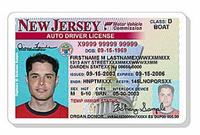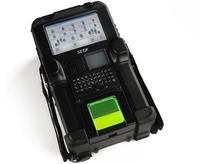-
Portable iPod Touch fingerprint scanner launched
IPod Touch users can now turn their devices into a portable fingerprint scanner; last week, Fulcrum Biometrics unveiled its new FbF mobileOne biometric fingerprint reader and software for the iPod touch; using the Touch’s standard dock connector, the mobileOne device can scan and match fingerprints on the iPod or send it wirelessly to a remote server for authentication
-
-
States turning to new "familial DNA" tests, practice faces legal hurdles
Law enforcement officials in several states across the United States are hoping to obtain the legal authority to begin conducting “familial DNA” testing, a process which could greatly increase the number of suspects identified in violent crimes; while DNA is often found at crime scenes using familial DNA would allow law enforcement officials to use DNA from a suspected criminal’s relatives to positively identify them; currently only California and Texas have laws in place that allow investigators to conduct familial DNA tests; Virginia, Pennsylvania, and Florida could soon join their ranks; the practice is still quite new and faces legal challenges and must be approved by a state’s courts
-
-
New Jersey launches sophisticated new driver's license

In compliance with Secure ID, the federal law that mandates that states create more stringent identification cards, New Jersey has unveiled a sophisticated new driver’s license; according to New Jersey officials, the new Enhanced Digital Driver’s License puts New Jersey among the ten states with the most secure identity cards; to prevent counterfeiting, security features include an embedded pattern on the license, one and two dimensional bar codes, and “purposeful errors” like misspellings; to implement these new licenses, the state’s MVCs have had to undergo a $19 million upgrade to install new computer systems, hardware, and software
-
-
Sector Report for Tuesday, 10 May 2011: Authentication / Biometrics
This report contains the following stories.
-
-
Arizona police deploy iris scanners and facial biometrics to identify inmates
Local police departments in Arizona have begun using facial biometrics and iris scanning technology to identify inmates and registered sex offenders; officers with the Pinal County Sheriff’s department have entered roughly 1,500 inmates and 700 sex offenders into a national database to better identify, register, and track inmates; the scans come as part of a broader effort led by the National Sheriff’s Association (NSA) and the U.S. Justice Department; beginning in 2009, the Justice Department awarded $500,000 to help roughly forty-five law enforcement agencies throughout the United States to purchase iris scanners from BI2 Technologies
-
-
Morpho's fingerprint algorithms win
Morpho (Safran group) the other day announced that its fingerprint recognition algorithms have been ranked number one in the two most recent National Institute of Standards & Technology (NIST) MINEX II (Match-on-Card) and Ongoing MINEX revaluations; the company says its algorithms excelled in both accuracy and interoperability under all conditions
-
-
Malaysia begins fingerprinting all visitors
Under a new trial program, next month the government of Malaysia will begin scanning the fingerprints of all travellers entering and exiting the country to help combat international crime and terrorism; the program, dubbed the Biometric Fingerprint Security System, is aimed at reducing fraud from the current screening method which involves a security official matching a traveller’s face to their passport photo; 3 percent of the 24.4 million foreigners who visited Malaysia last year were involved in crimes; biometric scanners are currently being installed at sixty-one of Malaysia’s ninety-six ports of entry, and the trial program will begin 1 June
-
-
Growth of adolescent fingerprints can be predicted
One difficulty law enforcement faces is recognizing whether the fingerprints taken during adolescence and in adulthood were those of the same individual; German researchers have developed a new procedure enabling the growth of fingerprints to be predicted
-
-
Cross Match's SEEK II may have identified bin Laden

SEEK II from Florida-based Cross Match is a 4-pound computer that captures photographs, complete fingerprints, and iris scans; its memory holds the images and biometrics of up to 60,000 people; unconfirmed reports suggest that the Navy SEALs who killed bin Laden used a SEEK II to identify him; there are about 5,000 SEEK II devices in the field, being used by the U.S. military, border patrol, and law enforcement agencies, and also by other militaries
-
-
Sector Report for Tuesday, 26 April 2011: Authentication / Biometrics
This report contains the following stories.
-
-
Ceelox unveils fingerprint authentication for cloud networks
Ceelox, Inc. recently announced the release of Ceelox ID Online which is a biometric solution designed specifically for cloud computing applications; users can now use their fingerprints to securely authenticate their credentials, minimizing the threat of having their user name and password stolen or compromised; stolen passwords and online identity theft has risen dramatically in recent years; from mid-2005 to mid-2006 alone, roughly fifteen million Americans were the victims of fraud related to identity theft; with Ceelox ID, users also have the flexibility to use one password for all their accounts to increase flexibility and convenience, while maintaining security
-
-
Precise Biometrics makes it easier for firms to build hardware
The longest delays in the production of biometrics hardware has been the integration of fingerprint recognition software, but thanks to a recently released product by Precise Biometrics, hardware manufacturers will find it even easier to build their devices; Precise Biometrics announced the launch of BioMatch Embedded, a software product that enables hardware companies to quickly and easily integrate fingerprint verification into their products; the firm says that rapid design, development, and testing is a key factor in how competitive a hardware manufacturer, and Precise Biometrics’ believes that BioMatch Embedded will help speed up this process
-
-
Biometric meetings to tackle security issues
A meeting in Washington, D.C. on 5-6 May, organized by the Centre for Policy on Emerging Technologies , this event is part of the RISE project (Rising pan-European and International Awareness on Biometrics and Security Ethics), a task 2 initiative sponsored by the Directorate European Research Area of the European Commission that aims to contribute to the creation of a common strategic vision on responsible biometric innovation among the main international players, will address the issue of biometric security in a global perspective
-
-
Government plan for consolidated online ID unveiled
Last Friday President Obama unveiled a plan to establish federal standards to create consolidated secure online passwords; the ultimate goal of National Strategy for Trusted Identities in Cyberspace (NSTIC) is to create a more secure environment for online transactions where users only have to register once and can use a common password for multiple sites; NSTIC lays out the industry standards and technology policies around the new authentication methods but leaves the development and deployment of the technology entirely in the hands of the private sector to avoid the establishment of a government-led national ID; privacy advocates worry that it could create an environment where authentication is increasingly required
-
-
Brazilian police get biometric "Robocop" glasses
Facial-recognition glasses have been deployed by Brazilian police ahead of the 2014 World Cup soccer tournament; the system can scan and compare four hundred faces per second using 46,000 biometric points for comparison; the technology will be tested at public events leading up to the World Cup
-
- All
- Regional
- Water
- Biometrics
- Borders/Immig
- Business
- Cybersecurity
- Detection
- Disasters
- Government
- Infrastructure
- International
- Public health
- Public Safety
- Communication interoperabillity
- Emergency services
- Emergency medical services
- Fire
- First response
- IEDs
- Law Enforcement
- Law Enforcement Technology
- Military technology
- Nonlethal weapons
- Nuclear weapons
- Personal protection equipment
- Police
- Notification /alert systems
- Situational awareness
- Weapons systems
- Sci-Tech
- Sector Reports
- Surveillance
- Transportation
Advertising & Marketing: advertise@newswirepubs.com
Editorial: editor@newswirepubs.com
General: info@newswirepubs.com
2010-2011 © News Wire Publications, LLC News Wire Publications, LLC
220 Old Country Road | Suite 200 | Mineola | New York | 11501
Permissions and Policies
Editorial: editor@newswirepubs.com
General: info@newswirepubs.com
2010-2011 © News Wire Publications, LLC News Wire Publications, LLC
220 Old Country Road | Suite 200 | Mineola | New York | 11501
Permissions and Policies
